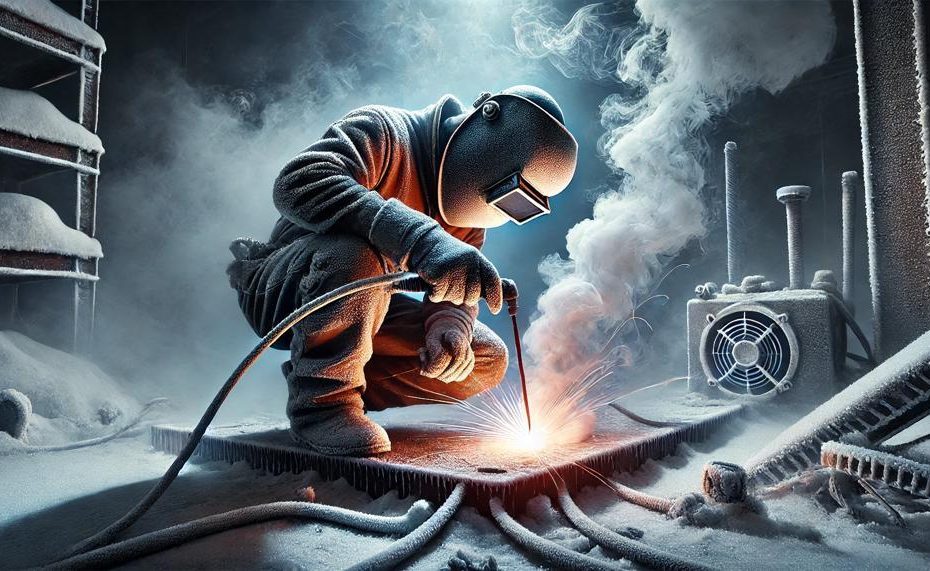Imagine stepping into the world where metals bond seamlessly without the intense glare of a flame or the buzzing of an arc welder. Welcome to the captivating universe of cold welding. This isn’t a scene from a futuristic novel but a fascinating reality in the realms of manufacturing and material science. Cold welding, a process that seems almost magical, allows two metal pieces to fuse together without the need for heat, melting, or traditional welding techniques.
In this blog post, we’ll dive deep into the heart of cold welding, exploring its mechanisms, marvels, and the myriad of applications it opens up for industries ranging from aerospace to electronics. Here’s what you’ll uncover as we peel back the layers of this intriguing subject:
- The Science Behind Cold Welding: Understand the physics that allows metals to bond at room temperatures.
- Advantages Over Traditional Welding: Discover why cold welding is a game-changer for certain manufacturing processes.
- Practical Applications: From repairing pipelines in space to creating seamless electronic connections, see how cold welding is applied in real-world scenarios.
- Challenges and Solutions: Learn about the hurdles faced by engineers and how they’re overcoming them to harness the full potential of cold welding.
Designed to strike the perfect balance between casual and professional, this introduction aims to enthrall both novices and experts alike. Whether you’re a seasoned engineer, a curious student, or simply fascinated by the latest in technology and science, this article promises to shed light on a process that might just redefine the future of material science and manufacturing. Let’s embark on this journey together, exploring the cold, yet incredibly warm world of cold welding.
Contents
- 1 What Is Cold Welding?
- 2 The History of Cold Welding: A Surprising Discovery
- 3 How Does Cold Welding Work? The Role of Diffusion
- 4 Advantages of Cold Welding: Why It’s a Preferred Method
- 5 Limitations of Cold Welding: When It May Not Be Suitable
- 6 Achieving Successful Cold Welds: Factors to Consider
- 7 Applications of Cold Welding in Different Industries
- 8 Conclusion
What Is Cold Welding?
Absolutely, let’s break down cold welding in a way that’s easy to grasp. Imagine you have two pieces of metal, and you want to stick them together without melting them. That’s what cold welding is all about. It’s like magic, but with science.
What Is Cold Welding?
At its core, cold welding is a process where two pieces of metal are joined together without heating them up. Instead of using a flame or electric arc like in traditional welding, cold welding relies on applying a lot of pressure. This pressure pushes the two metal surfaces so close together that their atoms mix and fuse, creating a bond as if they were one piece.
Also Read: # How Does It Work? – A Simplified Explanation
| Step 1: Clean Surfaces | You start by making sure the metal surfaces are squeaky clean. Any dirt or oxidation can mess up the process. |
| Step 2: Apply Pressure | Then, with a bit of elbow grease (and a machine), you apply pressure to press the metals together. No heat needed. |
| Step 3: Atomic Fusion | The pressure causes the atoms from each metal surface to get cozy and merge, creating a solid bond. |
Why Use Cold Welding?
- No Heat: Since there’s no heat involved, there’s no risk of distorting or weakening the materials.
- Cleaner Process: It doesn’t produce any harmful fumes or change the metal’s properties.
- Precision: Ideal for delicate jobs where precision is key, like in electronics or jewelry making.
Any Downsides?
Sure, it has its quirks. It only works well with similar metals and requires both surfaces to be immaculate. Plus, it’s not great for big, bulky items since they need to be under high pressure.
In a nutshell, cold welding is like giving two metals a super-strong handshake that lasts forever.
The History of Cold Welding: A Surprising Discovery
Cold welding, a groundbreaking method for fusing metals without the need for heat, emerged from a blend of curiosity and meticulous observation by several key figures in physics and engineering. This process fundamentally relies on the principle that two clean, flat metal surfaces can bond through atomic attraction when brought into intimate contact under pressure. The initial discovery and subsequent explorations into cold welding have paved the way for its application across diverse industries, from aerospace to jewelry making.
| Year | Scientist(s) | Contribution |
| 1928 | Johann Gottfried Tropsch | Noted the potential for clean metal surfaces to bond under sufficient force. |
| 1941 | P.G. Nuttall and R. M. Boseley | Demonstrated cold welding in practice with aluminum wires. |
| 1946 | Fritz Heusler | Observed cold welding phenomena during gold wire production, marking the first recognized discovery of cold welding. |
Fritz Heusler’s pivotal observation in 1946 while exploring the production of gold wires through hammering essentially laid the foundation for understanding and harnessing cold welding. His work illustrated that under certain conditions, metals could form strong atomic bonds without melting or applying external heat sources. This discovery challenged conventional welding methods and opened new avenues for material engineering and manufacturing processes.
Following Heusler’s discovery, the contributions of Johann Gottfried Tropsch in 1928 and the collaborative efforts of P.G. Nuttall and R.M. Boseley in 1941 further elucidated the mechanisms and potential applications of cold welding. Their collective research highlighted not only the prerequisites for successful cold welding, such as clean surfaces and adequate pressure but also its limitations, including the necessity for precise conditions and surface preparation.
Cold welding’s unique ability to join dissimilar metals without altering their intrinsic properties while producing no harmful by-products has made it an invaluable technique across various sectors.
How Does Cold Welding Work? The Role of Diffusion
In the intriguing world of welding, cold welding stands out as a unique method that defies the conventional reliance on heat to fuse metals. Instead, it leverages the power of pressure to join materials in a way that’s both elegant and efficient. So, what role does diffusion play in this process? Let’s dive in.
Cold welding, or contact welding as it’s sometimes known, is a process where two clean, flat metal surfaces are joined together under high pressure. Unlike traditional welding methods that rely on heat to melt and merge materials, cold welding relies on the concept of solid-state diffusion. This is where diffusion steps into the limelight.
Diffusion, in the context of cold welding, is the movement of atoms across the boundary of two metals when they are pressed together. Under the right conditions – pressure being a critical factor – atoms from one piece of metal migrate into the neighbouring piece, creating a bond at room temperature without the need for melting. This migration of atoms across the interface essentially “welds” the metals together at a microscopic level.
Let’s break down this concept further with a simple table:
| Aspect | Role in Cold Welding | Impact on Weld |
| Pressure | Initiates contact between metal surfaces | Creates conditions for atomic migration |
| Clean Surfaces | Removes barriers to diffusion (e.g., oxides) | Enhances atomic interaction and bond strength |
| Atomic Migration (Diffusion) | Atoms move across metal boundaries under pressure | Fuses metals at a microscopic level without heat |
Thus, diffusion is not just a participant in the cold welding process; it’s the star of the show. It allows metals to be bonded without altering their intrinsic properties—a boon for applications where thermal distortion is a no-go. From aerospace components that demand precision to delicate jewellery that cherishes integrity, cold welding through diffusion offers a solution that traditional methods can’t match.
Advantages of Cold Welding: Why It’s a Preferred Method
The main benefits of using cold welding over traditional welding methods are numerous, offering both practical and technical advantages across various industries. Below is a table highlighting these key benefits:
| Benefit | Description | Impact |
| Heat-Free Bonding | Cold welding creates bonds without the need for external heat, preventing material distortion and weakening. | Preserves the original strength and integrity of the materials, making it ideal for sensitive applications. |
| Material Compatibility | Enables joining of dissimilar and traditionally non-compatible metals, such as aluminum to stainless steel. | Expands design possibilities and applications in industries where material properties are critical. |
| Versatility | Suitable for a wide range of metals and thicknesses, with some processes joining materials up to 6 mm thick. | Offers solutions for aerospace, automotive, and other sectors requiring precision metal joining. |
| Efficiency | Eliminates the need for external heat sources or gases, streamlining the welding process. | Reduces operational costs and time, enhancing productivity in manufacturing settings. |
| Eco-Friendly | Lack of heat or gases makes cold welding a more environmentally friendly option. | Supports sustainability goals by reducing energy consumption and emissions in the welding process. |
| Risk Reduction | Avoids thermal damage to materials, preserving their mechanical properties and appearance. | Minimizes rework and waste, ensuring high-quality joins with less risk of failure in critical applications. |
Cold welding stands out as a preferred method due to its unique combination of strength, versatility, and efficiency.
The ability to join dissimilar metals without compromising their integrity opens new avenues for innovation across various sectors. Furthermore, its eco-friendly profile aligns with the growing demand for sustainable manufacturing practices.
Limitations of Cold Welding: When It May Not Be Suitable

When eyeing whether cold welding hits the nail on the head for your welding project, a few nooks and crannies need your attention. Here’s the lowdown:
| Type of Metal | Cold welding is picky; it likes metals that mirror each other, such as pairing aluminum with aluminum. Mix-matching metals with different melting points? That’s a recipe for a weak bond. |
| Size and Thickness | Think thin. We’re talking less than 0.3mm thin. Thick metal pieces are tough cookies for cold welding, requiring more pressure and friction than you might have up your sleeve without some hefty equipment. |
| Joint Design | Keep it simple. Lap joints or butt joints are your best bets. They offer a larger bonding playground for the metals, leading to a more robust weld. Complex designs? They’re like trying to thread a needle wearing boxing gloves. |
| Desired Strength of the Weld | If you’re after Hercules-level strength and durability, cold welding might not be your hero. For those instances, traditional heat-based welding methods might be more your speed. |
In essence, choosing cold welding comes down to matching your metals, sizing them right, opting for straightforward joints, and being realistic about the strength you need.
Achieving Successful Cold Welds: Factors to Consider
Achieving successful cold welds hinges on several critical factors. Each plays a pivotal role in ensuring that the metallic bond formed is robust and durable. Here’s a breakdown:
| Factor | Description | Contribution to Success |
| Metal Type | Selection of ductile, nonferrous metals like aluminum or copper. | Ensures compatibility and ease of welding, given these metals’ propensity for cold welding. |
| Surface Preparation | Thorough cleaning and brushing to remove oxide layers. | Critical for creating a clean, contaminant-free interface for the metals to bond. |
| Pressure Applied | Enough force to cause 35% to 90% deformation at the joint. | Facilitates the breaking of the oxide layer, allowing direct metal-to-metal contact necessary for bonding. |
| Joint Design | Choice between butt joints and lap joints depending on metal preparation. | Determines the effectiveness of the bond based on how well the joint design accommodates pressure application and metal flow. |
| Metal Condition | Avoiding previously hardened metals. | Ensures that the metals are in a state that allows for effective cold welding, maintaining ductility. |
To delve into each factor:
- Metal Type: The essence lies in choosing materials amenable to cold welding. For instance, aluminum and copper are stars in this arena due to their softness and ductility.
- Surface Preparation: Imagine trying to glue two pieces of paper together, but one is covered in dust. No matter how much glue you use, they won’t stick properly. That’s akin to attempting to cold weld without removing the oxide layer.
- Pressure Applied: It’s not just about brute force; it’s about applying it wisely. Too little and you won’t break through the oxide layer; too much, and you could damage the metals.
- Joint Design: This is where your planning takes physical shape. A well-thought-out joint design ensures that when pressure is applied, it’s distributed in a manner conducive to bonding.
- Metal Condition: If you’ve ever tried bending a hardened piece of metal, you know it doesn’t budge easily. The same principle applies here; softer metals are more amenable to forming those crucial bonds.
In essence, mastering cold welding isn’t just about squishing two pieces of metal together; it’s an art form that requires attention to detail, precise conditions, and a bit of alchemy.
Applications of Cold Welding in Different Industries
Cold welding, with its unique ability to join metals without heat, offers a slew of advantages across various industries, crafting robust bonds while preserving the integrity of delicate materials. Below is a detailed table showcasing the specific applications of cold welding in different fields and how it benefits each industry.
| Industry | Benefits | Applications |
| Aerospace | Ensures precision and strength, vital for aerospace components. Maintains material integrity and supports aerodynamics. | Joining small, delicate parts such as fuel tanks and engine components without thermal distortion. |
| Automotive | Creates lightweight yet sturdy vehicles by joining dissimilar metals without compromising their properties. | Manufacturing car bodies using different metals like aluminum and steel, producing parts like exhaust systems. |
| Medical | Provides clean and sterile joints crucial for medical devices, able to withstand sterilization processes. | Production of medical devices and surgical instruments where cleanliness and precision are paramount. |
| Electronics | Allows precise bonding of tiny components without heat damage, crucial for the miniaturization trend in electronics. | Joining computer chips, circuit boards, and other minuscule electronic components. |
| Oil and Gas | Avoids thermal damage to pipelines, maintaining their integrity for safe operation. | Pipeline repair and maintenance, manufacturing of valves and sensitive components without introducing heat. |
In essence, cold welding’s knack for uniting metals sans heat plays into the strengths needed across these varied industries. For aerospace, it’s about not compromising on precision or strength; in automotive, it’s leveraging the technique for eco-friendly innovation.
The medical field values it for its sterile application, while in electronics, it’s all about getting down to the nitty-gritty without frying delicate circuits. And in the oil and gas sector, keeping pipelines intact without thermal intervention is key.
This technique isn’t just about joining metals; it’s about pushing forward industry standards and paving the way for advancements that seemed out of reach.
Conclusion
In the big picture of material science and production, cold welding stands out as a novel thread that connects the realms of possibility with the strands of new ideas. Instead of the hot hug of traditional welding, this process uses a cold but close atomic fusion. It’s not just a big step forward in technology; it’s also a big change in how we think about metalwork.
From flight wonders to electronic details, we’ve learned a lot about the ins and outs of cold welding. It’s clear that this isn’t just another method; it’s a way to reach new heights of design and efficiency.
Cold welding is an example of how creative people can be; it makes things that were once thought to be impossible possible. It’s an eco-friendly lighthouse in a world that cares about energy efficiency; it joins metals together without flames or fumes, keeping their purity and qualities. There are many ways to use this method, and its flexibility makes it great for delicate tasks where accuracy is key and heat is not welcome. But, as with any new idea, it comes with obstacles. To reach that perfect union, it needs perfect conditions and careful planning.
We are on the verge of a new era in production as companies around the world continue to use this cold magic to push the limits and set new standards. Cold welding isn’t just another way to put metals together; it also lets us rethink what’s possible in design, building, and other fields. We’re not just connecting things when we use this method; we’re also connecting the present and the future of technology progress.
It has done a lot of good things, and it can still do more. That’s why we should celebrate cold welding. Between these two cool metals is a warm ball of possibility that holds great promise for many businesses.





